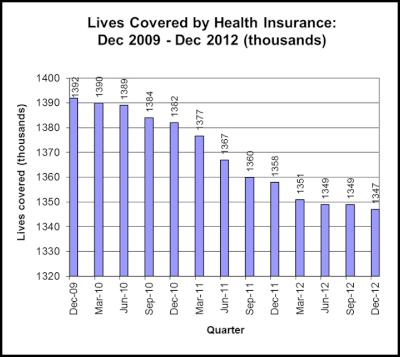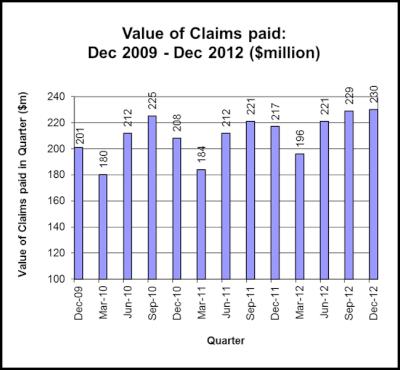Record health claims underline sector’s value: HFANZ
February 11, 2013
MEDIA RELEASE – FOR IMMEDIATE
USE
Record health claims underline sector’s value: HFANZ
2012 was another record year for health insurance claims paid – at $876 million – up 5.2 percent on the 2011 year, according to figures released today by the Health Funds Association.
HFANZ chief executive Roger Styles said the figures underlined the valuable contribution made to healthcare funding by the 1.35 million people with health insurance in New Zealand.
However, Mr Styles said New Zealanders needed to be aware they would be required to make an even bigger contribution to future health care costs, as health pressures built and public finances were stretched.
He pointed to the Treasury’s recent release of papers for the review of the Government’s long term fiscal statement, which focused on addressing the unsustainable growth in public sector health spending.
“Treasury’s paper notes New Zealand’s heavy reliance on public funding, and accepts that this likely needs to change in favour of a more balanced level of private funding. The sorts of options canvassed include specific withdrawal from certain publicly provided services and increasing use of co-payments.
“It is good that these options are starting to be flagged now. We need broader public debate on some of these suggestions,” Mr Styles said.
But he cautioned that the debate on options needn’t be restricted to public sector rationing, user charges or service cuts.
“There is room for more thought on the role of health insurance as a tool to assist in proactively planning for a more balanced and sustainable health system,” Mr Styles said.
The OECD recommended in 2009 that New Zealand should consider a greater role for health insurance – in the interests of both fiscal sustainability and healthcare market competition.
Mr Styles said HFANZ supported this call, and had long advocated that there was a strong public policy case for measures to restore greater public-private balance in the health system.
The latest statistics showed the rate of decline in health cover had slowed significantly. The number of people with health insurance dropped just 0.1 percent for the December 2012 quarter, although it was down 0.8 percent for the year. Claims paid for the December 2012 quarter totalled $230 million, the highest ever recorded for a quarter. Premium income for the December 2012 year was up $55 million, or 5.3 percent, on the same period in 2011, to a total of $1.092 billion.
ENDS (Three-page
statistical summary follows)
Health Insurance
Statistics December 2012
This is a quarterly
supplement providing statistical information for the health
insurance industry in New Zealand. It contains data on the
most recent quarter, ended December 31,
2012.
Lives covered dip slightly in December quarter
The number of lives covered was down by 0.1 percent in the December quarter (-1400) at 1,347,400. For the 12 months ending 31 December 2012, the number of lives covered fell by 10,700 or 0.8 percent.

The past three years from December 2009 to December 2012 has seen a decline of 45,000 lives covered, or 3.2 percent.
Lives covered by
age
A breakdown of the lives covered by age group indicates the reductions have been spread across most age groups, although they are mostly concentrated among those of working age. The decline in coverage for those aged between 35 and 59 accounts for over three-quarters of the total reduction across all age groups.
The table below shows the overall movements for the year for each five-year age band.
Table: Lives Covered by Age group: December 2011
and December 2012
| Age | Lives covered December 2011 | Lives covered December 2012 | Change | Percent |
| 0–4 | 65,819 | 65,037 | -782 | -1.2% |
| 5–9 | 80,746 | 82,275 | 1,529 | 1.9% |
| 10–14 | 86,325 | 84,864 | -1,461 | -1.7% |
| 15–19 | 91,945 | 89,327 | -2,618 | -2.8% |
| 20–24 | 77,593 | 76,988 | -605 | -0.8% |
| 25–29 | 67,831 | 67,532 | -299 | -0.4% |
| 30–34 | 79,789 | 80,616 | 827 | 1.0% |
| 35–39 | 100,284 | 96,821 | -3,463 | -3.5% |
| 40–44 | 117,512 | 116,860 | -652 | -0.6% |
| 45–49 | 122,689 | 119,439 | -3,250 | -2.6% |
| 50–54 | 122,192 | 122,107 | -85 | -0.1% |
| 55–59 | 109,506 | 108,587 | -919 | -0.8% |
| 60–64 | 96,666 | 94,382 | -2,284 | -2.4% |
| 65–69 | 59,170 | 61,820 | 2,650 | 4.5% |
| 70–74 | 36,212 | 37,081 | 869 | 2.4% |
| 75–79 | 20,371 | 20,415 | 44 | 0.2% |
| 80–84 | 13,950 | 13,648 | -302 | -2.2% |
| 85–89 | 7,057 | 7,124 | 67 | 0.9% |
| 90+ | 2,365 | 2,454 | 89 | -10.9% |
| Totals | 1,358,037 | 1,347,387 | -10,650 | -0.8% |
Premiums paid up 5.3 percent
Health insurance earned premiums in the December 2012 quarter were $277 million, up slightly on the $275 million for the September 2012 quarter. Premium income for the full year ended December 31, 2012, totalled $1,092 million, an increase of $55 million or 5.3 percent on the $1,037 million in premium income for the December 2011 year.
Increased premium income reflects adjustments
following rapid growth in claims costs over recent
years.
Claims paid up 5.2 percent
Health insurance claims paid in the December 2012 quarter totalled $230 million, the highest ever recorded for a quarter, ahead of the previous record claims paid of $229 million in the previous quarter ended September 2012.
Claims paid in the 12 months to December 2012 totalled $876 million. This is an increase of $44 million, or 5.2 percent, on the total claims paid in the 12 months to December 2011.
Growth in claims costs has been running at a high level over recent years due to increased demand, expansion of services funded, and medical inflation, although the rate of growth has slowed in the last year or two, mainly reflecting the fall in lives covered.



 Hugh Grant: How To Reduce Network Bottlenecks
Hugh Grant: How To Reduce Network Bottlenecks Dominion Road Business Association: Auckland Transport's 'Bus To The Mall' Campaign: A Misuse Of Public Funds And A Blow To Local Businesses
Dominion Road Business Association: Auckland Transport's 'Bus To The Mall' Campaign: A Misuse Of Public Funds And A Blow To Local Businesses Parrot Analytics: A Very Parrot Analytics Christmas, 2024 Edition
Parrot Analytics: A Very Parrot Analytics Christmas, 2024 Edition Financial Markets Authority: Individual Pleads Guilty To Insider Trading Charges
Financial Markets Authority: Individual Pleads Guilty To Insider Trading Charges Great Journeys New Zealand: Travel Down Memory Lane With The Return Of The Southerner
Great Journeys New Zealand: Travel Down Memory Lane With The Return Of The Southerner WorkSafe NZ: Overhead Power Lines Spark Safety Call
WorkSafe NZ: Overhead Power Lines Spark Safety Call



